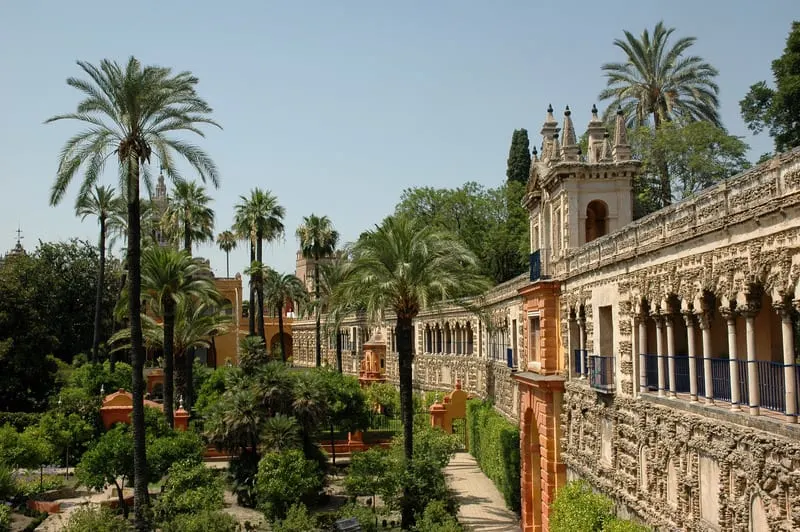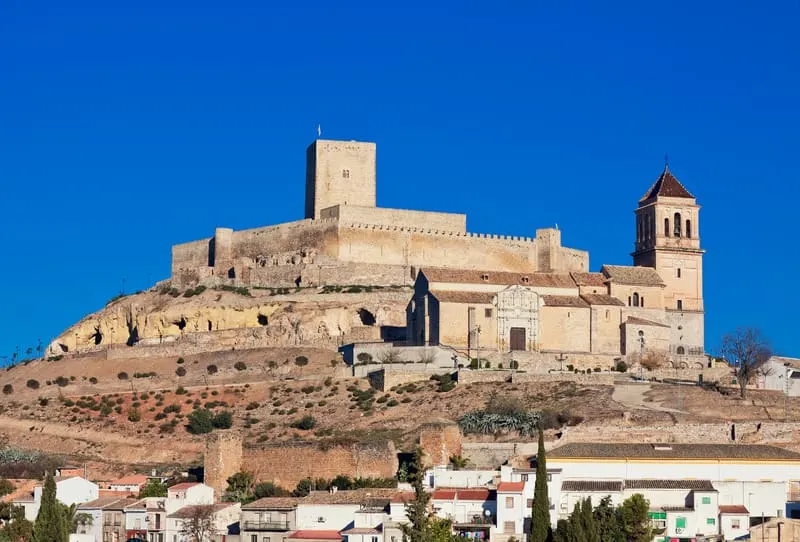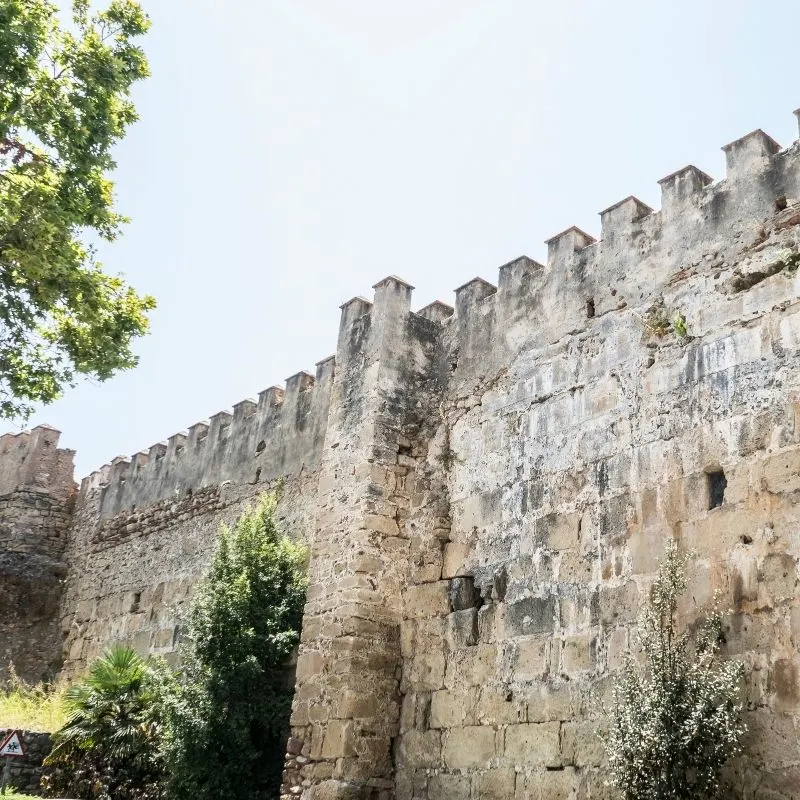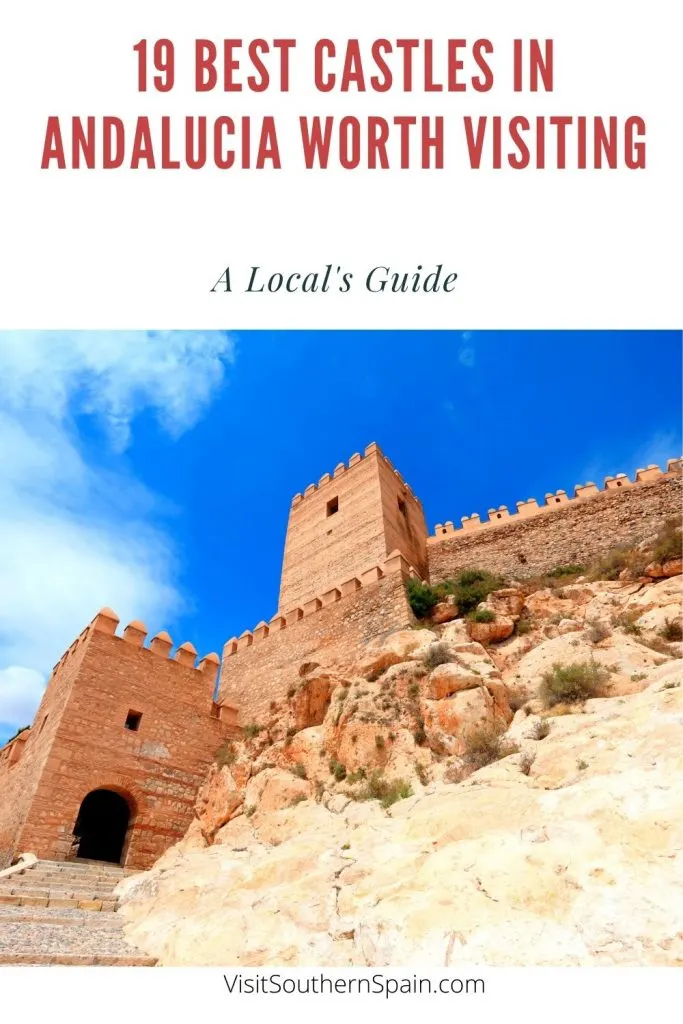The ultimate guide to the best Castles in Andalucia that you should visit
No matter where you venture in Southern Spain, you are bound to stumble upon a castle of one kind or another.
With a history dating back to the Phonecians, every civilization that has conquered Andalucia has left its mark on the landscape.
Be it the Carthaginians, Romans, Vandals, Visigoths, Moors, or Christians; each dynasty built fortresses and castles to protect their lands.

You, dear reader, support this blog. If you purchase through a link, we earn a small commission. As an Amazon Affiliate, we earn from qualifying purchases.
While the majestic castles tend to be in places with a large population, all along the Andalucian coastline, you will come across smaller castles and towers.
Originally built to warn of an imminent invasion, these watchtowers played an essential role during the 17th century when the Barbary pirates were the scourge of the Mediterranean.
Looking back into Andalucia’s rich history, we have compiled a list of the best castles in Andalucia to visit while vacationing in southern Spain.
Top Castles in Andalucia
Of all the castles to visit in Andalucia, Spain here are our six must-see castles are listed below:
- Colomares Castle (Benalmadena): Built in 1987 as a monument to Christopher Colombus, Colomares Castle is a mix of architectural styles with hidden details in every corner.
- Alhambra Palace (Granada): Arguably the most famous of all the Nasrid Palaces, the Alhambra Palace in Granada is on everyone’s bucket list.
- Alcazaba De Málaga: Towering over the city of Malaga, the Alcazaba De Málaga was built by the Hammudid dynasty in the early 11th century.
- Castillo De La Torre De Guzmán (Cádiz): Once the nucleous of the town during the 14th and 15th centuries the Castillo De La Torre De Guzmán was later used by fisherman to spot tuna.
- Castillo De Niebla (Huelva): Regarded as one of the best-preserved Moorish fortifications in Andalusia, the Castillo De Niebla has parts that date back to the Romans.
- Castillo de Marbella: While known for being a jet-set playground, Marbella also has an impressive fortress built by the Moors.
Short History on the Best Castles in Andalucia

During the 700 years of Moorish rule, the Emir’s of Al-Andalus built fortresses along the borders of their land in strategic locations.
These fortifications would play a significant role during the Reconquista as the Catholic Monarchs battled the Muslims.
Today, many castles in Andalucia are open to the public. Some of the most important ones have been magnificently restored, while others have been left in a state of ruin.
If you want to have a full Andalucian experience we encourage you to choose from some of the most stunning villas to rent in Andalucia and plan your next 1 week itinerary in Andalucia with the help of your guide.
Accommodation in Southern Spain has a lot to offer as you can imagine, and you can choose to stay at some of the best boutique hotels in Andalucia.
19 Best Castles in Andalucia Worth Visiting
1. Generalife Granada

Along with the magnificent Al Hambra, Granade is also home to the Generalife summer palace and gardens.
Dating back to the late 13th and early 14th century, the Generalife was the summer home of the Nasrid rulers of the Emirate of Granada.
During the hot summer months, the rulers would move their court from the Al Hambra due to its higher elevation and an abundance of trees that provided shade.
Initially, the Generalife would not look as it does today as a large part of the area would have been put aside for agriculture and places where animals could graze.
To supply the Generalife and Alhambra with water, the Moors built a series of canals stretching for 3.7 miles to a reservoir which in turn is fed by the Darro River.
Today the Generalife is one of the oldest surviving Moorish gardens globally and a must-see attraction for anyone visiting Granada.
Opening times:
October 15th – March 31st Monday to Sunday 08:30 – 18:00. April 1st – October 15th Monday to Sunday 08:30 to 20:00.
Admission:
While most people buy tickets for the Alhambra and Generalife as a package, it is possible just to buy a ticket for the Generalife for 7.00€.
You can find guided tours here
2. Alcazaba De Málaga

Sitting on a hill above a Roman amphitheater and below the Castle of Gibralfaro, the Alcazaba De Málaga is a palatial fortification built in the early 11th century.
According to experts, the Alcazaba of Málaga was the prototype for several Moorish fortresses in the Taifa period.
Its massive entry fortifications and double walls are similar to the Crusader Krak des Chevaliers castle in Syria.
Besides the imposing castle, there are many other things to do in Malaga, like touring the Picasso museum and the open-air Muelle Uno.
If you visit during the run-up to Christmas, be sure to see the fantastic music and lights show on Calle Larios.
Opening times:
09:00 to 20:00 (Last entry time at 19:30).
Admission:
3.50€ one monument; 5.50€ combined Alcazaba and Gibraltar.
3. Alhambra Palace (Granada)

If you only have time to visit one castle or fortress in Spain, make it to the Alhambra Palace in Granada.
The construction of one of Spain’s most known Nasrid Palaces was begun in 1238 by Muhammad I Ibn al-Ahmar, the first Nasrid Emir and founder of the Emirate of Granada.
Later, Moorish rulers modified the Alhambra until the Christian armies captured it during the Reconquista.
With its splendid Islamic architecture and heavenly gardens, the Alhambra is one of the most visited castles in Andalucia.
If you plan to visit the Alhambra, be sure to purchase your tickets beforehand. There are a limited number of tickets sold each day to keep the number of visitors at a manageable level.
To avoid the crowds and the hot midday sun, we recommend visiting the Alhambra during the morning.
Open:
Seven days a week from 08:30 to 20:00
Admission: 14.00€
Check out the guided tour here
4. Royal Alcazar Palace (Seville)

Royal Palace is a UNESCO-listed architectural treasure that recalls Seville’s Arab influences and has since been reconstructed in the successors’ architectural styles, making it one of Spain’s most diversified and unusual architectural monuments.
You’ll see azulejos and horseshoe arches everywhere, as well as floral decorative patterns, mosaics, tapestries, and Renaissance finishes.
Visitors appreciate this well-known tourist site for its stunning gardens full of blooming trees and plants. It’s no surprise that it’s regarded as one of the best things to do in Andalusia for first-time tourists.
If you’re planning to visit this city during the holidays, we recommend Easter in Seville as is one of the most beautiful celebrations in Spain.
Remember to purchase your tickets in advance online! Early morning is the best time to see the Alcazar in Seville, and if you don’t have tickets, try to be at the box office at least an hour before it opens to avoid queuing.
5. Colomares Castle (Benalmadena)

Located in the Spanish resort town of Benalmádena, Castillo de Colomares is a monument dedicated to the life and times of Christopher Columbus.
Constructed between 1987 and 1994, it was designed to resemble a fancy castle and covers an area of 5,000 square feet.
While it may be the most significant monument of its kind in the world dedicated to the Italian navigator, it is in the Guinness Book of World Records for having the smallest church at just over six square feet.
Colomares is one of the most majestic castles in Andalucia that you should not miss!
Opening times:
Wednesday to Sunday 10:00 to 14:00 and 16:00 to 20:00
Admission:
Adults 2.50€ children 2.00€
6. Castillo De La Torre De Guzmán (Cádiz)

Located in the town of Conil de la Frontera the Castillo De La Torre De Guzmán was erected around 1295 by Alonso Pérez de Guzmán.
The town of Conil de la Frontera is strategically located on the Atlantic Ocean and was often attacked by Muslims from North Africa.
The tower was incorporated into the city’s walled defenses to warn the population of impending Muslim raids.
Later, the fisherman used the building to spot giant bluefin tuna as a lookout point. Free to visit the tower offers excellent views of the town and beaches.
Open:
11:30 to 14:00 and 16:30 to 18:30 Closed on Sunday and Monday.
Admission: Free.
7. Santa Catalina Castle (Jaen)

Overlooking the Spanish city of Jaen, the Santa Catalina Castle was constructed in the 8th century by the Moors and later improved upon by the Abdallah ibn al-Ahmar, the first ruler of the Emirate of Granada.
Following the siege of Jaen and the capture of the castle in 1246, King Ferdinand III of Castile added to the fortress building a new section on the eastern extreme of the hill.
Today the Santa Catalina Castle is home to one of the best Paradores in Andalucia.
With views of the Guadalquivir River valley stretching to the Sierra Morena mountains, the Santa Catalina and its Parador hotel are one of the best places in Jaen to watch the sunset.
Opening times:
Open seven days a week from 10:00 to 18:00
Admission:
Adults 3.50€ Children 1.50€
8. Castillo De Sancti Petri, San Fernando (Cádiz)

Situated on a small island south of the city of Cadiz in southwestern Spain, the Castle of Sancti Petri is built on the remains of a Phoenician and then Roman temple.
Of an irregular shape and made in the style of the Moors, the castle is a defensive fort dating back to the 13th century.
Over the years, the castle started to deteriorate but was rescued by an effective rehabilitation program and later declared a Spanish Cultural Monument.
You can visit the castle by boat from the harbor at Sancti Petri or rent a sea kayak on Sancti Petri Beach if you are up to it.
Opening times:
Monday to Thursday, Saturday and Sunday, between 11:00 and 19:30. Friday between 11:00 and 14:00.
Access to the castle occurs every hour on hour during the entire visiting day. Tip: If you visit on Friday, the entrance to the castle is free.
Admission:
Adults 7.50€ Children 5.00€
9. Castillo de Marbella

Today, the Alcazaba of Marbella is all that is left of the Moorish walls that surround the town.
Sitting on a hill at the height of 98 feet above sea level, the castle is believed to date back to the 10th century when Abd al-Rahman III ruled the Caliphate of Córdoba.
The ruins are located in Marbella’s old town close to the Plaza de los Naranjos. When you are in Marbella, you should know that here you can find some of the best lakes in Andalucia that are worth visiting as well.
Opening times: You can only see the castle from the outside.
10. La Calahorra Castle (Granada)

While not one of the oldest castles in Andalucia, La Calahorra Castle does have the distinction of being one of the first Italian Renaissance castles to be built outside Italy.
Located in the foothills of the Sierra Nevada mountains in Granada, La Calahorra Castle was built between 1509 and 1512.
Flanked by four round towers with cupolas, the castle boasts a splendid inner courtyard featuring balustraded made from Carrara marble.
Opening times:
Only open on Wednesday’s 10:00-14:00
Admission: 5.00€
11. Antequera Castle

Overlooking the city of Antequera in southern Spain, the Alcazaba de Antequera offers stunning views over the surrounding countryside.
Built by the Moors on top of Roman ruins to hamper the Christian advance, the castle is typical of other Moorish castles in Andalucia and is an easy day trip from Malaga.
Open:
Monday to Sunday 10:00 to 18:00 the entrance price includes admission to the Real Colegiata de Santa María.
Admission:
Adults 6.00€ children between seven and sixteen 6.00€ under six free.
12. Castillo de Santa Ana (Almeria)

Built between the 16th and 17th centuries as a refuge for people escaping Barbary Pirate raids, the Castillo de Santa Ana was later mostly destroyed during an earthquake in 1804.
In 1997 the castle was re-built using the original plans as a guide. Today the castle is used to house art exhibits and has concerts in the inner courtyard during the summer.
Because of its location on Almeria’s Roquetas de Mar, a popular tourist destination, the castle attracts many visitors during the summer months.
Opening times:
Tuesday to Sunday 10:00 to 13:00 and then 18:00 to 21:00 closed on Monday.
Admission: Free
13. Castle Sohail (Fuengirola)

Located in Fuengirola on Spain’s sunny Costa del Sol, the Sohail Castle was built in AD 956 by Abd-ar-Rahman III to strengthen the coastal defenses.
In 1485 the castle was captured by Christian forces battling the Nasrid Kingdom, yet when no longer needed militarily fell into neglect.
Seeing its potential as a tourist attraction, the town of Fuengirola renovated the ruins in 2000 and today uses it to host exhibitions and musical events.
Opening times:
Tuesday to Sunday 10:00 to 14:00 and then 18:30 to 21:30 closed on Monday.
Admission: Free
14. Castillo de Bil Bil (Benalmádena)

Built on the instructions of a French couple to look like a Moorish palace today, the Bil-Bil Castle is one of Benalmádena’s most visited attractions.
Used as a private home following the war, Castillo de Bil Bil fell into disrepair and was going to be demolished before Benalmádena stepped in and decided to restore it and use it as a cultural center.
Opening times:
In summer, Castillo de Bil Bil is open during the mornings and evenings.
Admission: Free
15. Castillo de Almodovar

Located in the town of Almodóvar del Río, overlooking the Guadalquivir River, the Castillo de Almodovar is a castle of Muslim origin built on what was once a Roman fort.
Today the castle is owned by the 12th Count of Torravala and was used for the setting of Casterly Rock in the hit HBO series Game of Thrones.
Unlike many Spanish castles in Andalucia, the Castillo de Almodovar is a fancy castle with many exciting things to see and do.
A visit to Castillo de Almodovar makes for a wonderful day trip from Cordoba.
Opening times:
Monday to Friday 11:00 to 14:30 | 16:00 to 20:00
Weekends and holidays: 11:00 to 20:00
Admission:
Adults 9.00€ Children 5.00€
16. Castillo De Niebla (Huelva)

Located less than an hour’s drive from Seville, Castillo de Niebla in Huelva is one of the best castles in Andalucia worth visiting.
Roman, Visigoth, Moorish, and Christian, the Castillo De Niebla, is a look back into the history of Andalusia.
Partially destroyed during a 1755 earthquake and then bombarded by the French during the Peninsular War in 1812, the castle was re-built, restoring many of its original features.
Within one and a quarter-mile long wall called the ” Murallas de Niebla” there are six access gates and 50 towers.
Inside the castle, visitors can explore the armory and dungeons, and other rooms that look to recreate the castle’s history.
Opening times:
Tuesday to Sunday 10:00 to 18:00 closed Monday.
Admission: Free for children and normal ticket is 4.50€
17. Castillo De Zahara De La Sierra (Cádiz)

Constructed by the Moors to protect their land’s outer reaches, the Castle of Zahara de la Sierra is one of the most significant examples of the old medieval castles in Andalucia.
Fortified with battlements and outpost towers, the castle sits high on a rock between the Zahara reservoir and the Sierra de Grazalema Natural Park, Cadiz.
Despite changes being made following the Reconquista, the castle retains many of its Nasrid features.
In 1985 the Castillo De Zahara De La Sierra was named a Site of Cultural Interest. Getting to the castle requires a steep climb, but the reservoir and countryside views are worth the effort.
This is also the place where you will find one of the most stunning white villages in Andalucia, one that should be visited at least once in your life.
Opening times: Open 24 hours
Admission: Free
18. El Castillo De Olvera (Cádiz)

Also located in the province of Cádiz, the El Castillo De Olvera, like the Castillo De Zahara De La Sierra, was built to protect the moors from the advancing Christian armies.
Situated high above the town of Olvera, the castle was built to compliment the rock it sits on. Owned and looked after by the city of Olvera, the castle is well maintained and looked after.
Opening times:
Tuesday to Sunday from 10:30 to 14:00 and from 16:00 to 19:00 Closed Monday.
Admission: 2.00€
19. El Castillo De Alcalá De Guadaíra
Built on a hill overlooking the town of Castle of Alcala de Guadaira, El Castillo De Alcalá De Guadaíra was built by the Moors during the 12th and 13th centuries.
Despite being abandoned for two centuries, restoration work on the castle began in 1998, restoring it to its Medieval splendor. Now’s on the list with some of the best castles in Andalucia.
Opening times:
Tuesday to Friday 09:30 to 13:30. Saturday 10:00 to 14:00 and then 16:00 to 18:00. Sunday 10:00 to 14:00.
Closed on Monday.
Admission: Free
Best Hotels in Jerez, Southern Spain
With a wealth of exciting things to see and do, it will come as no surprise to learn that after France, Spain is the most popular tourist destination in the world.
Because choosing where to stay can be a complicated affair, we have listed three suggestions to match any budget.
Hotel Palacio De Villapanés, Seville ***** – Luxury
Housed in a renovated 18-century palace just outside the Santa Cruz neighborhood of Seville, the 5-star Palacio Villapanés is one of the best boutique hotels in Seville.
The Palacio Villapanés has 50 rooms, five of which are suites, and is a member of The Best Small Hotels In The World.
The hotel’s location is ideal for people wanting to discover the city’s old quarter and is within easy walking distance of all the main attractions. Features at the hotel include:
- Rooftop sun terrace
- Plunge pool
- Free WiFi
- Satellite TV
- Air conditioning
- Telephone
- Bar
- Restaurant
- On-site parking
- 24 concierge
- Airport shuttle
Seville is arguably one of the best cities in southern Spain and will give visitors insight into life in Andalucia.
Besides the wonderful restaurants and tapas bars, there are also plenty of things to do in Seville, so you must visit during your vacation in Spain.
Finca Monasterio, Cadiz **** – Mid-Range
Located a short drive from Gibraltar and just ten minutes from Sotogrande and its world-class golf courses, the 4-star Finca Monasterio is an ideal place to relax and unwind.
Housed in what was once an 18- monastery, the Finca Monasterio features 30 luxury air-conditioned ensuite rooms surrounding a typical Andalucian courtyard.
Features at the Finca Monasterio include the following:
- Restaurant
- Bar
- Business center
- Spa
- Swimming pool
- Free WiFi
- Ground floor rooms with private terrace
Nearby Sotogrande is a hidden paradise of palatial villas and tree-lined avenues.
Purposely designed for the moneyed crowd, Sotogrande is teaming with fine dining restaurants and chic boutiques selling all the latest designer fashions.
The blue flagged beaches are spotlessly clean and a Marina on par with anything Puerto Banus offers.
Check out prices & reviews here
Hotel Palacio Guzmanes, Jaen *** – Budget
Located not far from the Unesco World Heritage towns of Úbeda and Baeza in the historic center of Baños de la Encina the 3-star Hotel Palacio Guzmanes offers modern cozy rooms with beautiful views.
Occupying a building built in the 17th century, the hotel is just off the main A4 motorway that links Madrid with the Costa del Sol.
Features at the property include the following:
- Airconditioned rooms
- Restaurant
- Pub
- Free WiFi
- Swimming pool
- Game room
- Parking
Set in the historic center of Baños de la Encina, Jaen, the Hotel Palacio Guzmanes is the perfect base for exploring everything this beautiful part of Spain offers, including Burgalimar Castle, the oldest castle in Spain.
Short FAQ about the Best Castles in Andalucia
Which places provide the best castles in Andalucia for kids and families?
While there is no doubt that the Alhambra and the Generalife palaces are two of Spain’s top attractions, having kids in tow can become a little stressful due to the crowds.
A great alternative is to visit the ocean side city of Cadiz. Having grown rich on trade from the New World, Cadiz not only has two incredible castles but miles of sandy beaches for some fun in the sun.
What is the oldest castle in Spain?
Constructed in 968, Burgalimar Castle in the town of Baños de la Encina, Jaen is the oldest castle in Spain and one of the oldest in Europe.
Having spanned seven monarchs throughout its long history, Burgalimar Castle is also known as the Castle of the Seven Kings.



Hola, I’m Paulina! Together with my team, we are passionate about Southern Spain. Here we share all you need to know for great times in Southern Spain with the best places to visit, stay and, of course, the best food to eat.
Let’s dive in and explore Southern Spain’s outdoors, food and culture con pasión!







